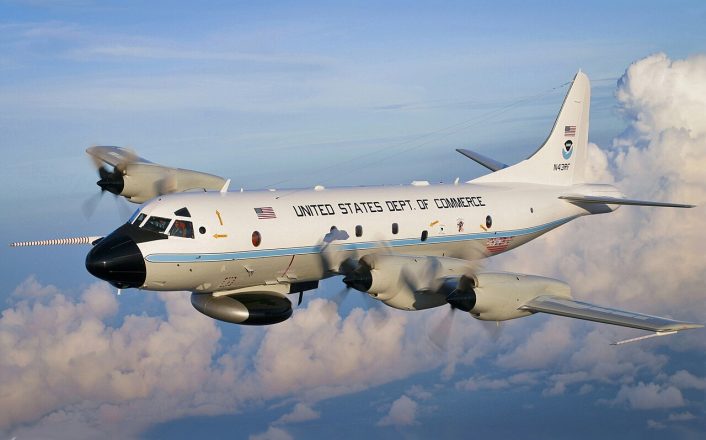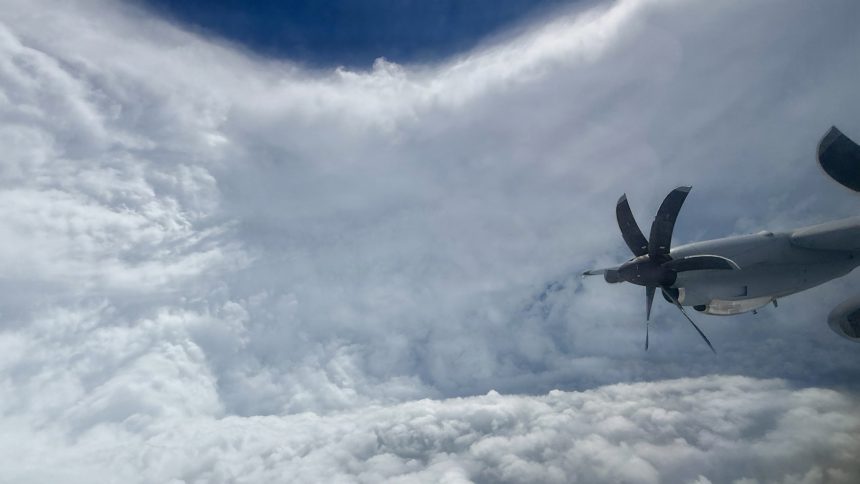A U.S. Air Force WC-130J Weatherbird from the 53rd WRS, as well as NOAA aircraft, have had to abandon planned missions early due to the strength of Hurricane Melissa.
Weather reconnaissance aircraft have been operating at an extraordinarily high tempo in recent days to gather data on Hurricane Melissa as it threatens to devastate communities across the Caribbean. These include civilian-operated WP-3D Orions from the U.S. National Oceanic and Atmospheric Administration (NOAA) as well as WC-130J Weatherbirds from the U.S. Air Force’s 53rd Weather Reconnaissance Squadron (WRS), collectively known by the nickname ‘Hurricane Hunters’.
These aircraft collect information on storms by flying directly into them, including into the ‘eye’. Sensors fitted to the aircraft, as well as dropsondes, provide the crew on board with live information on a wide range of parameters. This data can then be recorded and relayed to the National Hurricane Center (NHC) who will use it to inform predictions of the storm’s path and intensity, in turn informing the NHC’s advice on sheltering or evacuating.
On Oct. 28, 2025, just hours before Hurricane Melissa made landfall on Jamaica, the 53rd WRS reported via social media that one of their aircraft had encountered beyond normal turbulence while operating near the eye of the storm. The aircraft, flying under the mission callsign TEAL 75, was forced to abort its mission under safety rules which require an aircraft to be inspected for damage after exceeding stated stress limits.
— Hurricane Hunters (@53rdWRS) October 28, 2025
The squadron’s statement reads: “A 53rd Weather Reconnaissance Squadron crew (call sign TEAL 75), known as the Air Force Reserve Hurricane Hunters, is returning to it’s forward operating location in Curaçao after encountering heavy turbulence today while entering the eye of Hurricane Melissa, a Category 5 storm. During the event, the aircraft briefly experienced forces stronger than normal due to turbulence. While this does not automatically indicate damage, standard safety procedures require an inspection before returning to operations.”
This footage from inside the eye of Category 5 Hurricane Melissa might be the most jaw-dropping video ever captured of a hurricane’s eye, showcasing the infamous “stadium effect.” pic.twitter.com/AEhj2g2Ban
— Colin McCarthy (@US_Stormwatch) October 27, 2025
In NOAA’s daily report for Oct. 27, the previous day, it too had said the intensity of Storm Melissa had forced the early return of its aircraft: “Reports from NOAA and Air Force Reserve Hurricane Hunter aircraft indicate the central pressure has fallen to near 908 mb, with both aircraft releasing dropsondes in the northeastern eyewall that support an initial intensity of 145 kt. The NOAA aircraft left the storm early after experiencing severe turbulence in the southwestern eyewall.”
A display of pure power from Hurricane Melissa today.
Remarkable satellite imagery. pic.twitter.com/TpBvmdZxlw
— Dakota Smith (@weatherdak) October 28, 2025
Possible video of the right eye wall of Hurricane #Melissa in Black River, Jamaica pic.twitter.com/SfEYQf7dSz
— Reed Timmer, PhD (@ReedTimmerUSA) October 28, 2025
NOAA warns of life-threatening conditions in Jamaica, Haiti, the Dominican Republic, Eastern Cuba, the Southeast Bahamas, and the Turks and Caicos Islands. Oct. 28’s daily report issued the following for Jamaica: “THIS IS AN EXTREMELY DANGEROUS AND LIFE-THREATENING SITUATION! TAKE COVER NOW! Catastrophic winds with total structural failure are liklely near the path of Melissa’s center. Catastrophic flash flooding, landslides, and destructive winds are expected across the remainder of the island causing widespread infrastructure damage, power and communication outages, and isolated communities. Along the southern coast, life-threatening storm surge and damaging waves are expected through the day.”
“LAST CHANCE TO PROTECT YOUR LIFE.”
I’ve never seen the National Hurricane Center say this.
Melissa is now the 5th most-intense Atlantic hurricane ever recorded, making landfall at the same strength that Dorian did in the Bahamas. 2.8 million lives will change in moments. pic.twitter.com/zFbwGYW16k
— Matthew Cappucci (@MatthewCappucci) October 28, 2025
After Jamaica, Hurricane Melissa is expected to hit Cuba, including the U.S. base at Guantanamo Bay. Evacuations have been undertaken of non-essential personnel and equipment ahead of the storm’s arrival. Government sources in Jamaica and Cuba have said both nations, which are expected to be the hardest hit by the hurricane, have taken as many precautions as possible to mitigate expected damage. Nonetheless, the storm is expected to cause significant loss of life in the region, and completely devastate many areas which already face struggles to access basic utilities.
Weatherbirds
The WC-130J Weatherbird, based on the ubiquitous C-130J Hercules, is the 53rd WRS’ primary Hurricane Hunter aircraft. Among its adaptations for the role are wing-mounted fuel tanks for extended range, a Stepped-Frequency Microwave Radiometer which monitors rainfall rates and winds below the aircraft, the dropsonde deployment system, and palletised monitoring stations that allow for the aircraft to be rapidly reconfigured back into an airlift role. Ten WC-130Js are in USAF service, all with the 53rd WRS.
Ten full-time crews of at least five personnel each are maintained along with ten part-time crews, who work together to fulfill mission readiness requirements directed by the National Hurricane Operations Plan. An average mission could take as long as eleven hours, with aircraft endurance allowing for up to 18 hours in the air when operating at optimum efficiency. All WC-130Js are based at Keesler Air Force Base, Mississippi, though are frequently deployed to forward operating locations when required.

NOAA’s smaller fleet of WP-3D Orions carry out largely the same missions, but crew members on board have the additional goal of gathering data for scientific research as well as for storm preparedness. The two WP-3Ds in service are due to be replaced by two WC-130Js from 2030. The new Weatherbirds will inherit many of the modifications made to existing USAF examples, but will additionally be fitted with the capability to deploy unmanned aerial vehicles while in flight.
This function is likely to also find its way onto the USAF fleet promptly, potentially allowing flights into even more risky conditions without the chance of losing crew members. Over the years since hurricane hunter flights were first flown a number of aircraft have been lost while carrying out the mission. Given the severity of the conditions the crews fly in, if the aircraft cannot fly out of the storm there is essentially no chance of a successful rescue.
Remarkably, despite the risk, the last fatalities during a Hurricane Hunter mission occurred in 1974 – also the only time that a WC-130 of any variant has been lost. A number of incidents have occurred since this time, but have resulted in the eventual safe recovery of the aircraft.









